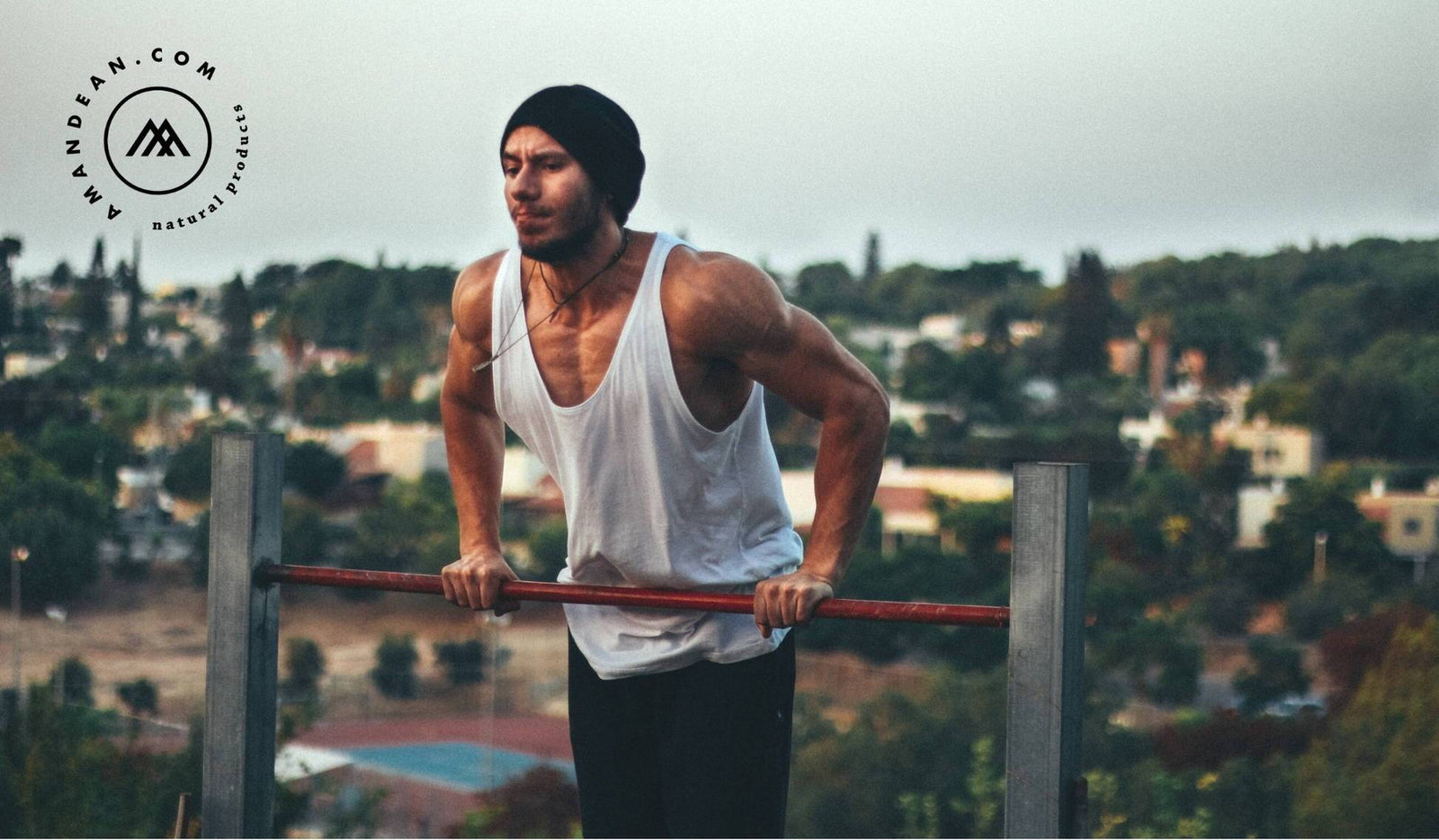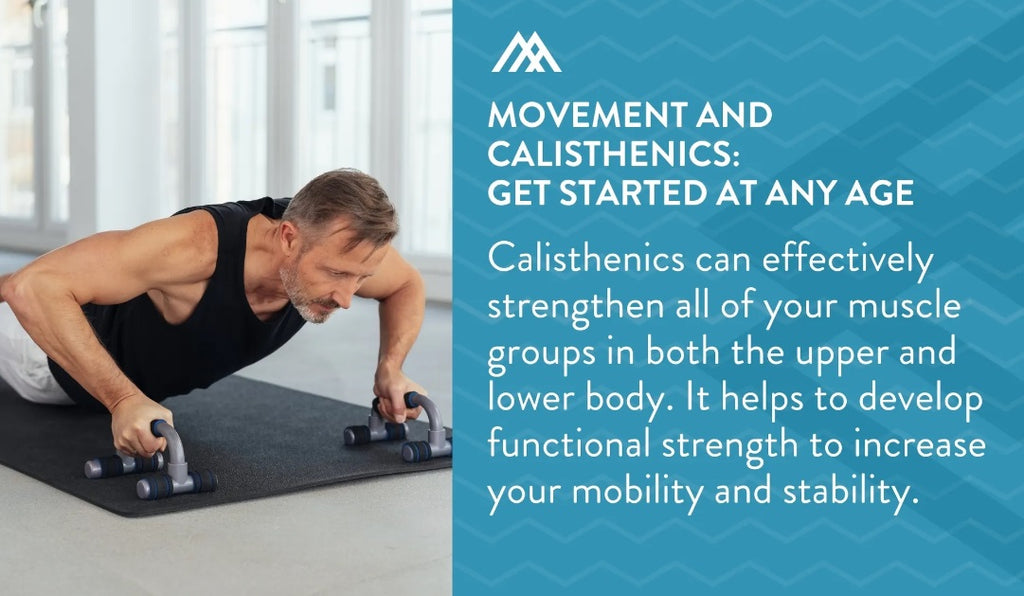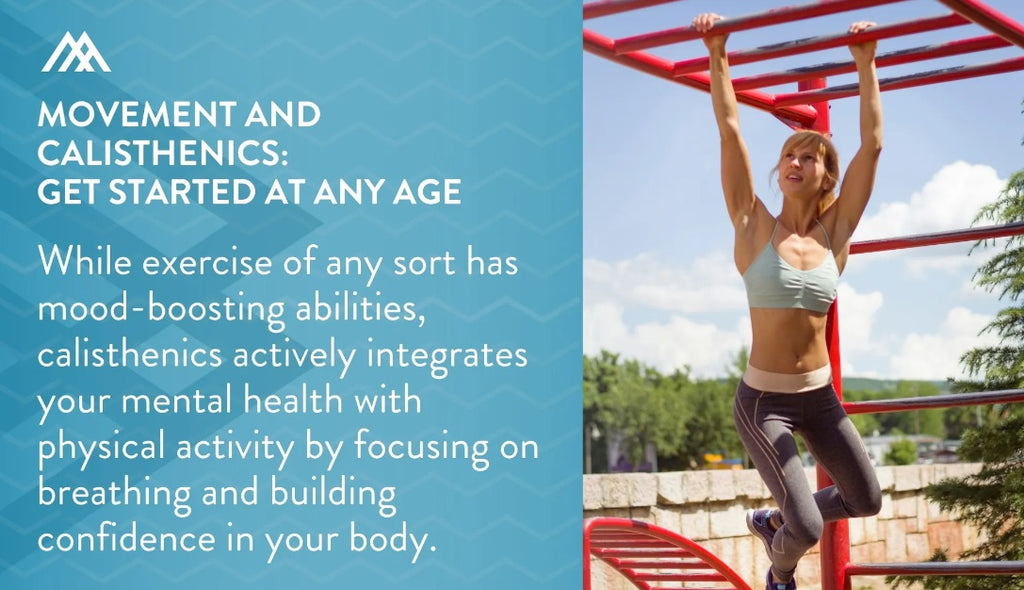Your Cart is Empty

January 21, 2021 6 min read
Calisthenics is a form of training that teaches you to master your own bodyweight. The word calisthenics comes from the Greek words, Kalos and Sthenos meaning ‘Beauty’ and ‘Strength’; It is the art of beautiful movement. Calisthenics takes a very natural approach to body strength by placing an emphasis on mobility, control, and play. It doesn't look like your typical straight line bodyweight training program, nor does it drag on like one. Calisthenics aims to expand your range of motion and explore and improve on what your body can do, not what it looks like.
There are many different training styles, and usually it just depends on what you find rewarding and exciting. Some are more static and focus on achieving proper form for a handful of exercises. Others are more flashy (hello flagpole flyers) and try to achieve impressive stunts. Others are more playful, almost like dance. There really is no single "right" form of calisthenics exercises, but expanding your range of motion and exploring different movements will not only keep you entertained and motivated, it activates and strengthens a wider range of muscles for more well-rounded mobility.

Calisthenics isn't a fad either. In Ancient Greece, around 1000 BC, soldiers and warriors were trained in calisthenics. Shaolin monks also famously train using their body weight and have done so for centuries. Have you ever seen people working out on playground equipment like it's a gymnastics routine or doing that insane human flagpole pose? Yep, that's calisthenics! If you think back to a time before 24/7 gyms or dumbbell sets delivered to your door, it makes sense why so many people practice it in so many different ways - there are no barriers to entry, all you need is your body. The same is true today. Wherever you are, at any age, you can begin your journey into calisthenics.
All you need is a body.One of the primary benefits of calisthenics is that you already have everything you need to get started and progress. Don't feel like going to the gym? Or rather, is your gym shut down due to a global pandemic? No worries! Don't have a personal trainer? No problem! All you need yourself. This obviously makes for a very cost-effective exercise routine too!
You don't need to be a pro.Since you go at your own pace and focus on what feels right and challenges your own body, it's great for beginners and can you easily build up (both in muscle mass and control) as you practice.

You'll build functional strength.Calisthenics can effectively strengthen all of your muscle groups in both the upper and lower body. It helps to develop functionalstrength to increase your mobility and stability rather than just increasing your heart rate or gaining muscle mass for the sake of appearance.
Helps to prevent chronic diseases.This gain in mobility and muscle mass can help to prevent sarcopenia, bone density loss, falls, and injuries that often come about with old age. Regular exercise also supports cardiovascular health, fat loss, and weight control while preventing heart disease and high blood pressure. All of these health benefits combined can help you to combat and manage chronic conditions.

You'llfeelbetter mentally...and have fun!Last but not least, calisthenics is a great supporter of your mental health and well-being. While exercise of any sort has mood-boosting abilities, calisthenics actively integrates your mental health with physical activity by focusing on breathing and building confidence in your body. Not only that, calisthenics are so fluid and flexible that it feels like play, not like a chore.
Right now is the perfect time to start exploring calisthenics! Part of strength training does involve more linear/basic movements (think push-ups, pull-ups, etc.) to help build muscle, but from there it is all about good form, creativity, and patience. If you want to increase the difficulty of any of these exercises, you can do so with added weight from barbells, resistance bands, increasing or decreasing leverage, or just by slowing down and working with gravity! This beginner workout routine will target the lower and upper body, and each exercise has different variations to help you find the route that's best for your level of mobility. These exercises are great for absolute beginners, seniors, or anybody that wants to gradually build up their mobility. Do short reps of 3-5 each as many times as you can, or at least 3 times.
Warm Up:
Start out with 5-10 minutes of light cardio such as walking in place or by pulling the knees to your core as you pull your arms up above your head and down again so that your elbows and high knee are at your core at the same time. If you prefer to dance, dance! Remember to keep it loose and fun. To increase the difficulty, increase your speed or try carrying weights.
Wall Push-Ups:
Next, we'll get into wall push-ups. Stand with your feet hip-width apart and face a wall. Place your hands shoulder-width apart then lower your chest towards the wall and let your heels come up off the floor. Hold your pose when you get close to the wall, then push through your hands to return to the starting position. To make this more difficult, you can do push-ups off of a table, desk, or sofa - the more horizontal your body is, the harder it will get.
Take our quiz and find which supplements your body is craving.

Chair Bodyweight Squats:
Stand in front of a chair with your feet hip-width apart. Keeping your chest upright, bend your knees into a squat until you are hovering above the chair seat. Hold it for a few seconds then lift with your legs until you are standing upright. Remember to go use very deep, controlled, and slow motions - focus on what muscles are being activated.
Lying Hip Bridges:
This exercise targets the glutes but might not be suited for people with severe lower back pain.
Lie down flat on your back (on the ground or a yoga mat) with your knees bent and your feet flat on the floor. Flatten your back against the floor, then push your hips into the air by squeezing your glutes together. You can use your feet to push your hips upward. Pause and hold this position at the top of the bridge, then in a very slow and controlled movement, lower back down and repeat.
Practice lowering yourself to the floor:
If you are able, practice slowly lowering your body to the floor in a squat. You can place your hands on a wall to control and guide your movements if needed. Try to get creative, taking into consideration your physical limitations, by trying to make each downward movement a little different. For example, try going into a deep squat (solely using your legs), then the next time, try spreading one leg out to the side at the bottom of your squat to get a teeny bit closer before you use your hands to balance and lower yourself completely. Try to rise in the same way using the same muscles that lowered you down. Focus on what muscles are activated and where you need extra support.
You can repeat these exercises daily to track your progress and explore what new muscle groups are firing!
Any approach to weight training or mobility should be holistic. By feeding your body nutrition that it needs to remain flexible and healthy, you can boost the results of your training, minimize your recovery time, and improve your mobility.

Collagen protein is a great place to start. Collagen is the most abundant protein in the human body and is responsible for keeping our joints flexible and strong. Amandean's Marine Collagen comes in an unflavored powder that can easily be added to coffee, pancakes, tea - you name it - to help boost your daily protein intake. Collagen supplements help to restore your body's natural collagen levels to strengthen connective tissues and help to manage and avoid joint pain. Boswellia extract is another powerful supplement that can help to ward off and manage inflammation. It was found to lessen the pain and swelling caused by osteoarthritis and rheumatoid arthritis. All of that, plus it keeps your skin firm, your hair long, and gut conditions at bay.
Together, these two supplements plus a little dedication and creativity can set you on a fast track to feeling and seeing the best results from your calisthenics training.
In Ancient Greece, around 1000 BC, soldiers and warriors were trained in calisthenics.
Shaolin monks also famously train using their body weight and have done so for centuries.
Calisthenics can effectively strengthen all of your muscle groups in both the upper and lower body, helping you develop functional strength to increase your mobility and stability.
While exercise of any sort has mood-boosting abilities, calisthenics actively integrates your mental health with physical activity by focusing on breathing and building confidence in your body.
Collagen supplements help to restore your body's natural collagen levels to strengthen connective tissues and help to manage and avoid joint pain.

May 14, 2024 8 min read

May 07, 2024 6 min read

May 07, 2024 6 min read